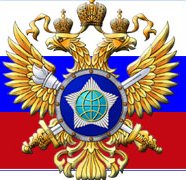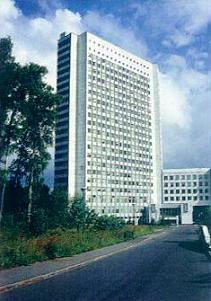|
|

Foreign Intelligence Service the SVRDirector – Sergei Naryshkin (since Oct 5, 2106), his predecessor - Mikhail Fradkov (appointed 9.10.2007)When the Soviet Union collapsed in late 1991 the KGB was divided into several independent agencies with the intention of preventing the emergence of another all-powerful security state. The KGB's former foreign intelligence directorate (The First Chief Directorate, or the PGU – Pervoye Glavnoye Upravlenye) was transformed into a new espionage agency called the Foreign Intelligence Service, or SVR by its Russian initials (Sluzhba Vneshnei Razvedki). Yevgeny Primakov, a well-known Arabist who spent years in the Middle East and had earned a reputation as one of the Soviet Union's leading experts on the region, was chosen to lead the now-independent bureau. In his previous posts he had contacts with the intelligence, and some of Primakov’s KGB colleagues were still at Yasenevo (PGU/SVR headquarters in a southern suburb of Moscow) when he took over the SVR; General Gurgenov accompanied Primakov during his visits to Saddam Hussein before the Desert Storm campaign in 1991 and General Kirpichenko, with whom he studied at the Oriental Institute, was his senior consultant. He also knew General Trubnikov (who served in India and Bangladesh), who was later to replace him as SVR director. All of them spent years in the East and they were to define the policy of the SVR in the years to come. Kirpichenko was appointed Chief of the SVR’s advisory board, Trubnikov was named First Deputy director and Gurgenov was made Deputy Director. Primakov even tried to hire back Leonid Shebarshin, the last chief of the PGU (Shebarshin spent his career as an intelligence officer in Pakistan, Iran and India), offering him the position of First Deputy Director, but Shebarshin declined the offer. For five years Primakov did his best to strengthen the SVR positions. According to Conflict Studies Research Centre's report in March 2000 by Gordon Bennett “The SVR Russia's intelligence service”:
But in public, Primakov's primary focus was on improving the SVR’s image. He wanted to distance the SVR from its KGB past as quickly as possible. Primakov's first step was to open a press office and he also encouraged SVR officials to present themselves in the Russian media as the most Westernized, liberal representatives of the Russian secret services. This was helped by the fact that the SVR was located in a Moscow suburb, far from the other intelligence agency spinoffs. Primakov also insisted that the agency have nothing to do with Russian internal affairs so that it wouldn't be tainted by any potential future suppression of domestic dissidents. Primakov retained some nefarious covert Soviet intelligence practices, such as the disinformation campaigns that were called "active measures." But he was keen to present the SVR as something more akin to a think tank or research institution. From 1993 through 1998, the SVR published four open research reports on international issues, including the proliferation of chemical and nuclear weapons. It was an effort obviously inspired by the CIA and Primakov even renamed the intelligence operatives "reviewers" or "analysts." In 1996 Primakov was appointed Foreign Minister, but he managed to secure the positions of his team at the service and Trubnikov was chosen as the next SVR director. Trubnikov was considered a direct successor in line with Primakov’s view of the SVR. When Putin was elected president in 2000, he was intent on putting his own stamp on the SVR. By tapping Sergei Lebedev to become the new SVR chief, Putin indicated he was intent on going in a different direction. Unlike Primakov's circle, Lebedev had spent his entire intelligence career in the West, working (like Putin himself) for the KGB in East Germany and for the SVR in the United States. When Lebedev selected Vladimir Zavershinsky, another former agent who had worked in Germany, as his first deputy it was clear that the agency's attention had shifted westward and that its stance was more antagonistic than it had been before. Almost immediately, three Western countries -- the United States, Britain, and Germany -- reported increased activity by SVR agents. On March 23, 2001, the U.S. State Department announced the expulsion of 50 Russian diplomats. At the time, it was considered the most serious spy scandal between the United States and Russia since the end of the Cold War. Two days later, British Prime Minister Tony Blair warned Putin about an increase in Russian intelligence activity in Britain. Four days after that Germany's counterintelligence service released a report concluding that Russia had increased the number of spies operating out of its diplomatic mission in the country. Putin eased up after the 9/11 terrorist attacks, even directing the SVR to aid the United States during the invasion of Afghanistan. Russians provided extensive on-the-ground intelligence during the war, especially on Afghan topography and the country's network of caves. Putin also ordered the shutdown of a monitoring station at Lourdes, Cuba, that was presumably used to gather intelligence on the United States and he allowed U.S. rendition flights to land and take off from a Russian airport. But the Russian détente didn't last long. In April 2003, reporters from the San Francisco Chronicle discovered documents in the Baghdad office of the Mukhabarat, the Iraqi secret police under Saddam Hussein, indicating that at least five Iraqi agents had graduated from a two-week surveillance course in Moscow. When the journalists asked Agentura.ru to check the documents our sources in the SVR confirmed that they were genuine. It quickly became clear that the Russians still wanted to foster an adversarial relationship with the West. In September 2007, Mike McConnell, then the U.S. director of national intelligence, told Congress that Chinese and Russian spies were stalking the United States with a fervor unseen since the espionage duels of the Cold War. In 2008, Germany's domestic counterintelligence service declared in its annual report that Russia and China were responsible for most of the intelligence-gathering activity in Germany. "Intelligence and security services are under orders to actively support Russian industry," the report said. In late 2007 Putin seemed to confirm the German allegation about the new trend in the SVR's activities. In December 2007 Vladimir Putin replaced the SVR chief Sergei Lebedev with Mikhail Fradkov, a former Russian prime-minister. Presenting the new director, Putin was quoted as saying: “The intelligence services need more actively to stand up for the defense of the economic interests of our companies abroad.” In 2009 the Russian intelligence activity in Germany was exposed once again. In June 2009 the director of Counterintelligence at the German intelligence agency, Burkhard Even, told Die Welt newspaper: “The Russian intelligence services, keeping up with their government's changing information needs, have intensified efforts in recent years to investigate German firms illegally.” The arrest of 10 Russian spies in the United States in June 2010 is further evidence of a Soviet flavor to the SVR’s tactics. Soviet and now Russian intelligence is renowned for two things -- it has its own full-spectrum higher learning institution and it uses so-called illegals. These illegals are Russians who integrate into their target country. These two aspects differentiate the SVR from the CIA and MI6 which do not have their own higher learning institutions and do not send out nationals to become Soviet or Russian citizens. There is one main reason why Soviet and Russian intelligence teach their employees in a specialized academy and uses these illegals -- its spies had their best days during Comintern (Communist International) intelligence in the 1930-40s. Back then the Soviet Union could count on the support of American, British, English and French Communists and sympathisers who had excellent educations and connections across the world. But after Soviet leader Josef Stalin killed these international Communists during the purges in the late 1930s, the Soviet spy masters were forced to create substitutes and they created a special higher learning institution to try to prepare former peasants for life as international spies. Sending out illegals was a desperate and not very successful attempt to replace Cominternists with home-grown cadres. It was not an overwhelming success. Their main use was in making contact with more conventional agents. Besides, early after the collapse of the Soviet Union it became clear that the greatest success for the Soviet secret service during the Cold War (the recruitment of double agents Aldrich Ames and Robert Hanssen who worked in the U.S. intelligence service and leaked dozens of classified information to Moscow) was the work not to illegals but of the classic intelligence officer Viktor Cherkashin who worked undercover in the Soviet embassy. In the 1990s, Russian intelligence was not under the same pressure as other special services and luckily avoided reorganizations (not taking into account Primakov's cosmetic reforms). Preserving tradition was considered one of the SVR’s main accomplishments – perhaps an inadvisable accomplishment for an intelligence agency.
|
|||||||


